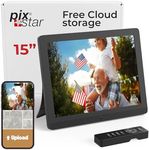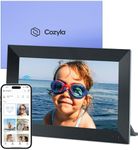Buying Guide for the Best Digital Frames
Digital frames are a modern way to display your favorite photos without the need for printing. They allow you to showcase a rotating gallery of images, often with added features like video playback or Wi-Fi connectivity. When choosing a digital frame, it's important to consider how and where you'll use it, what kind of photos you want to display, and how easy it is to update the content. Understanding the key specifications will help you find a frame that fits your needs and enhances your space.Screen SizeScreen size refers to the diagonal measurement of the display area, usually given in inches. This is important because it determines how large your photos will appear and how much space the frame will take up. Smaller frames (7-8 inches) are great for desks or bedside tables, while medium (10-12 inches) and large frames (15 inches or more) are better for living rooms or prominent display areas. Think about where you want to place the frame and how visible you want your photos to be when choosing the right size.
ResolutionResolution tells you how many pixels are used to display the image, usually shown as width x height (like 1024x768). Higher resolution means sharper and clearer photos, especially on larger screens. Low resolution (below 800x600) may look pixelated, especially up close. Medium resolution (around 1024x768 or 1280x800) is good for most uses, while high resolution (Full HD or higher) is best if you want crisp images and plan to display detailed photos. If you care about image quality, especially for close viewing, prioritize higher resolution.
Storage OptionsStorage options refer to how the frame holds your photos. Some frames have built-in memory, while others use SD cards, USB drives, or cloud storage. Built-in memory is convenient for a small number of photos, but if you want to display many images or videos, look for frames that support external storage or cloud syncing. If you like to update your photos often or have a large collection, choose a frame with flexible storage options.
ConnectivityConnectivity describes how the frame receives new photos. Basic frames require you to load images via USB or SD card, while more advanced models offer Wi-Fi or Bluetooth, allowing you to send photos directly from your phone or even receive them from friends and family remotely. If you want to update your frame easily or share photos with others, look for Wi-Fi-enabled frames. For simple, occasional updates, basic connectivity may be enough.
User Interface and ControlsThe user interface and controls determine how easy it is to set up and use the frame. Some frames have touchscreens, while others use buttons or remote controls. Touchscreens are intuitive and make it easy to browse photos or change settings, but buttons or remotes can be simpler for those who prefer traditional controls. Consider who will use the frame and choose a control style that matches their comfort level.
Supported File FormatsSupported file formats indicate which types of photo and video files the frame can display. Most frames support common formats like JPEG for photos, but if you want to show videos or less common image types, check the specifications. If you only plan to display standard photos, this may not be a big concern, but for more variety, make sure the frame supports the formats you use.
Extra FeaturesExtra features can include things like calendar and clock functions, motion sensors to turn the frame on or off, slideshow transitions, or the ability to play music. These features can add convenience or fun, but may not be necessary for everyone. Think about which extras would actually enhance your experience and focus on those when comparing frames.














